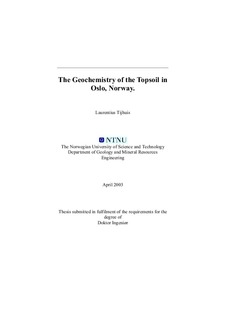| dc.description.abstract | In co-operation with the Geological Survey of Norway, 395 samples of topsoil, 44 bedrock samples and 24 samples of sand from sandboxes at kindergartens taken in Oslo, the capital city of Norway, were analysed for a wide range of elements. To get a measure on the bio-availability of arsenic, a five stage sequential extraction procedure was accomplished on a subset of 98 topsoil samples and on all 24 samples of sand from sandboxes. These fractions (i.e. “Exchangeable”, “Carbonate”, “Reducible substrate”, “Organic” and “Residual”) were analysed for arsenic. Bulk concentrations in a representative subset of 10 bedrock samples were determined by XRF analysis.
For the concentrations of the elements As, B, Ba, Cd, Cr, Cu, Hg, Mn, Mo, Ni, P, Pb and Zn in soil, geologic sources are important, but human activity has had a large effect on concentrations in topsoil, especially in the central districts. At least 81% of the samples contain more arsenic than the Norm value for polluted soil used by the Norwegian authorities. For chromium, zinc and lead, the percentages are 65, 74 and 25 respectively. In topsoil, up to 50% of the arsenic is extractable in the exchangeable, the carbonate and the reducible substrate fractions, but only 2% of the samples exceeded the Norm value after the three extraction stages. After four stages of extraction, 69% of the samples exceeded the Norm value.
At 24 kindergartens in the central districts of Oslo, concentrations of As, Cd, Cr, Cu, Ni, Pb and Zn in topsoil samples are higher than in samples of sand from sandpits, but differences in arsenic are low. All topsoil samples and 63% of the sandbox samples exceed the arsenic Norm value for polluted soil used by the Norwegian authorities. Concentrations of at least one of the elements Cr, Cu, Ni, Pb and Zn exceed the Norm value in the topsoil. At two kindergartens all elements, except Cd, exceed the Norm value in the topsoil.
In the samples from the sandboxes, arsenic concentrations in the exchangeable, the carbonate and the reducible substrate fractions, lie at a higher level than in topsoil samples. Leakage of arsenic compounds from impregnated and painted wood have probably caused elevated concentrations of this element in the sand. At two kindergartens the cumulative arsenic content in samples from the sandboxes exceeds the Norm value of 2 mg/kg As for polluted soil already after two fractions (i.e. the “Exchangeable” and the “Carbonate” fraction). After three fractions, the arsenic content in sand at 5 kindergartens exceeds this value. After four fractions this number was still 5. Regarding soil, no kindergartens had a cumulative arsenic content after three stages of the extraction procedure. After four stages 16 kindergartens contained more arsenic than the Norwegian Norm value of 2 mg/kg As.
Bulk concentrations of metals, in the bedrock samples, are generally higher than the acid soluble concentrations. Differences are small for copper and zinc, somewhat higher for lead and nickel and considerably different for chromium. Acid soluble chromium concentrations in soil differ little when compared with acid soluble concentrations in bedrock, but are in general much lower than bulk concentrations in rock. Chromium is probably strongly incorporated in the mineral structure of rock samples and concentrated HNO3 cannot solubilize all chromium molecules. For copper, lead and zinc, the acid soluble concentrations in soil are higher than the bulk concentrations in bedrock. The parent rock material cannot be the only source for these elements in soils and various anthropogenic sources dispersed by air or water probably have major influence.
The enrichment of nickel in topsoil near highways in Oslo might be due to the bitumen content of road dust. The enrichment of chromium and copper might be due to wear and tear of cars and engine parts. There is no enrichment of cadmium and zinc in topsoil near highways. Concentrations of zinc in topsoil in Oslo are generally high, most probably because of industry. The possible addition of zinc from traffic to the topsoil is not observed, in this study. | nb_NO |
